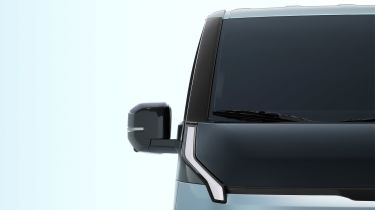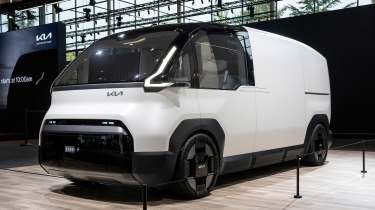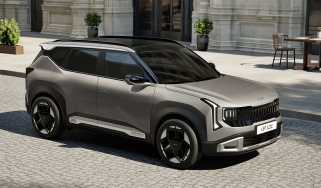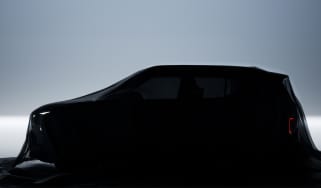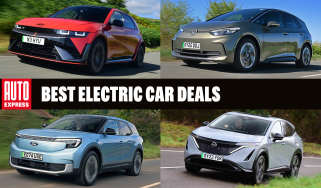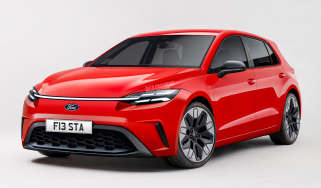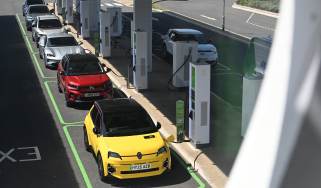New Kia PV5 teaser images tell us it will look very different to its electric van rivals
Latest pictures show the Kia PV5 will bring concept looks to the commercial vans class as it gears up for unveiling this month
The commercial vehicle sector isn’t exactly awash with unique, exciting designs these days – but Kia is looking to inject some style with the upcoming Kia PV5.
We’ve seen it testing on the road while the Korean company has previously issued official teaser images of its first-ever van. Now, ahead of its reveal on February 27 at Kia’s EV Day event, we’ve gained yet more clues as to what is in store.
These two new pictures constitute our best look yet at the new, mid-size all-electric panel van, which will also be offered as a high roof, chassis cab and crew cab.
The PV5 will rival the likes of the Citroen e-Dispatch, Vauxhall Vivaro Electric and upcoming models such as the next-generation Renault Trafic E-Tech. There’s also the Ford E-Transit Custom and the Volkswagen ID. Buzz Cargo – both of which have won our Electric Van of the Year award.
Kia’s concept cars generally receive very few styling changes before they reach production, and based on these images, the same will apply to its vans. The Concept PV5 revealed at CES 2024 previewed a bold, futuristic design that combines a simple one-box shape with an extremely stubby front end, large windows to maximise forward visibility and super-slim LED lighting influenced by the brand’s latest electric cars like the EV9 and EV3.
The thin LED lights will sit on a contrasting black panel, extending to the body paint – just as we saw on the concept. The wing mirrors are traditional mirrors, with the rear view camera stalks from the concept not visible. A teaser picture of the back of the PV5 again shows a light cluster that looks identical to the concept’s, with flush-fitting glass on the rear opening.
As well as the reveal of the PV5, EV Day will also herald the introduction of the brand’s PBV platform, and Kia says it will provide “full details of the business, vision, product line-up and launch to support the roll-out of the PV5”.
Paul Philpott, President and CEO of Kia UK, previously said: “Our first electric van, the PV5, arrives at an important time for the UK. Our strategy is to approach the market confidently but responsibly, launching in a phased and progressive manner to ensure each element of our commercial vehicle business is exacted with the same industry-leading standards we’re known for in the passenger car industry. This will cover dealer sales excellence, customer care, service and experience.”
Concepts of the various PV5 models shown at CES in Las Vegas back in 2024 showcased the company's ‘Easy Swap’ technology, which is designed to switch different ‘life modules’ into the back of a chassis cab-style platform.
The Easy Swap tech uses standardised electromagnetic and mechanical couplings to ensure security, while the platform's modular construction features high-strength tubular steel and engineered polymers that reduce typical part counts by 55 per cent, while maintaining chassis rigidity.
However, as mentioned previously, Kia isn’t just planning to launch one electric van. The Kia PBV (which stands for Platform Beyond Vehicle) is the name of the overall commercial vehicle strategy that the firm is developing, and two other models have already been shown in concept form. Kia has also declared every Kia PBV product will come with a seven-year/100,000-mile warranty as standard.
The PV7 is a typical large van like a Ford Transit or Renault Master, while the PV1 is designed as an autonomous small urban delivery vehicle, similar in size to a Citroen Ami, and features pivoting wheels at all four corners so that it can turn in its own length. These are meant to arrive in 2028/29.
Another model, the PV3, was previously teased at CES last year, and this is a more conventional small electric van in the mould of the Renault Kangoo and Citroen Berlingo, although no more details were forthcoming on that model.
New Kia PBV platform
Every Kia PBV will use an EV-dedicated platform that the company has developed, and has been designed to accommodate different wheelbase lengths, plus a wide variety of vehicle sizes and body types.
Kia has confirmed its PBVs will charge at up to 22kW from an AC power source like a wallbox, or 150kW from a DC rapid charger. They will also have vehicle-to-load (V2L) capabilities, allowing them to power electrical devices like tools or even refrigeration units. Meanwhile, Kia is working with several partners to develop specialised PBVs for specific needs.
Marc Hedrich, president of Kia in Europe, believes “In order to disrupt the LCV market, an all-in approach is needed to maximise the benefits of a dedicated platform for a wide range of customers.
“While this approach is not a first for electric passenger cars, it’s certainly the first time we see it for LCV. This is a benchmark moment, and our PBVs are set to deliver better accessibility, higher volumes, and lower running costs, to completely change logistics and mobility.”
When it’s launched, the PV5 will include advanced software connectivity as a precursor to introducing autonomous driving and delivery services. This is the initial phase of Kia's commercial vehicle plans, with phase two introducing the PV7 and PV1, as well as integrated AI and fully customisable systems that will be able to accommodate any use case possible, according to Kia.
Phase three will see the introduction of bespoke mobility solutions and connected self-driving vehicles that are part of a 'smart city' system, which is seen as an essential step on the path towards autonomous driving technology.
Click here for our list of the best electric vans...
Find a car with the experts

